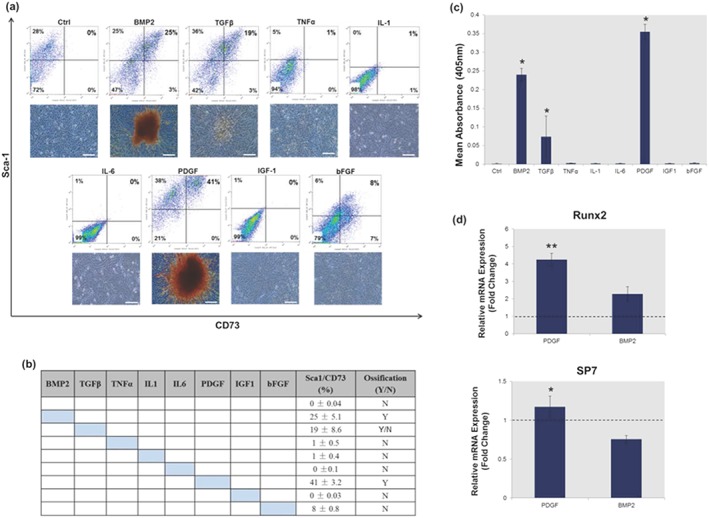Figure 5.

Mineralization can be induced in the undifferentiated ‘reserve’ cell population. (a) Flow cytometry profiling and accompanying Alizarin red staining identified a relationship between the presence of Sca‐1+/CD73+ cells and the formation of calcified nodules. (b) Exposure to tumour necrosis factor (TNF)α, interleukin (IL)1, IL6, insulin‐like growth factor (IGF)‐1 and basic fibroblast growth factor (bFGF) caused no significant increase in the number of Sca‐1+/CD73+ cells, and no corresponding mineralization was observed. (c) Alizarin red quantification showed that mineralization in the isolated ‘reserve’ cell population was significantly (p < 0.05) enhanced when skeletal muscle constructs were exposed to platelet derived growth factor (PDGF)‐BB or bone morphogenetic protein 2 (BMP2), respectively, when compared with untreated controls. (d) Gene expression analysis showed that PDGF‐BB promoted a significant (p < 0.05) increase in Runx2 and SP7 when compared with BMP2, which reduced SP7 expression when compared with C2C12 controls. All quantitative real‐time reverse‐transcription polymerase chain reaction analysis was performed at day 3 and normalized to untreated three‐dimensional controls using the ΔΔCT (Livak) method, indicated by the dashed lines. Coloured cells signify the addition of a growth/inflammatory factor. Bar: 100 μm. *p < 0.05, **p < 0.005; flow cytometry, polymerase chain reaction and Alizarin red quantification data are represented as mean ± standard deviation (n = 3)
